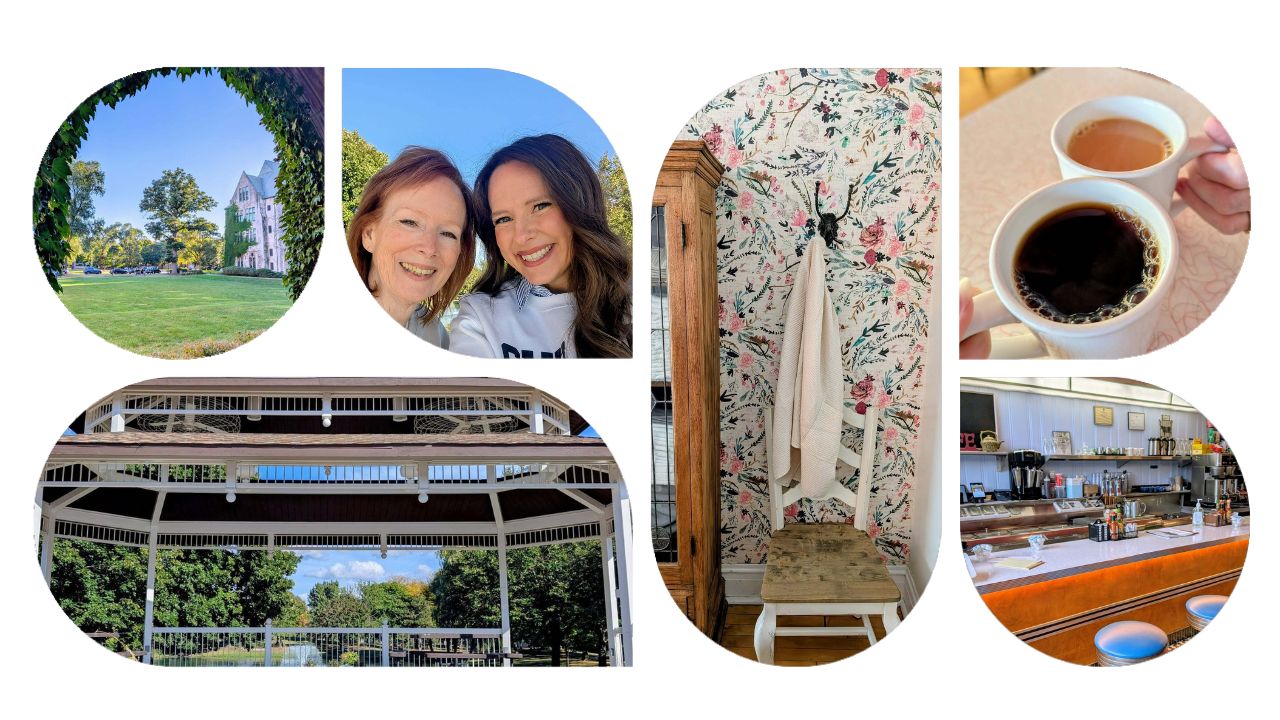I Followed My Own Itinerary: Here's What I Learned

I’ve always had a soft spot for the TV show Gilmore Girls. Not just the fast talking, but the feelings you get from watching. The show was set in a town that runs on coffee and neighborly chaos, a gazebo that seems to anchor the end of every day, and the sense that you could live a whole life within a few square miles. When I pitched “Stars Hollow at home” for Explore Oak Park and Beyond, what started as a love letter quickly became an itinerary for the perfect fall day in full Gilmore Girls fashion.
After it was published, I couldn’t stop thinking about it. Of course the route worked on paper, but I needed to make sure it played out just as I wanted it to in real life. So I cleared a Saturday, packed a camera, and decided to put my own playbook to the test, exploring pacing, mood, logistics, the tiny frictions you only find on the ground.
I didn’t go alone, of course. I brought the Lorelai to my Rory—my mom. Together we ran the full loop, from counter coffee to gazebo photos to a dinner that felt like a small celebration of our day. What follows are field notes from that day, including what landed, what I’d tweak, and how DMOs can use a simple road test to turn a cute idea into a dependable experience.
The Case for a Stars Hollow Saturday
Before we dive in, here’s the “why” behind our choice. Do I love Gilmore Girls? Yes. Did I want to road-test this itinerary myself? Also yes. But the pick wasn’t just personal; fan festivals and sold-out reunion events tell us the nostalgia of the show still has momentum.
That energy shows up in search traffic and social media trends, so we followed the signals. For a big slice of people, the first rewatch marks the start of fall—right up there with the first warm mug and the first scarf—so choosing this theme felt like great timing. Technically, this isn’t set-jetting, which is travel built around exact filming locations, often with long flights or pricey hotels. What we’re doing is set-jetting-adjacent. It’s not the exact filming locations, but the kind of places you’d swear could be. It’s how you hijack set-jetting.
We used the pattern we saw—spikes in searches and online chatter that repeats every September—and built a day that delivers the feeling without the airport sprint. That’s the promise here. If you’re a longtime fan, you’ll recognize the beats. If you’re new, you’ll still get a small-town arc with diner energy, bookish pauses, and a great finale. Our goal wasn’t to create a perfect replica but rather a local route that hits the same emotional notes and leaves you with a camera roll you’ll want to send to your group chat.
Why Field-Testing Your Own Itineraries Matters
One of the biggest lessons I’ve learned is that before you publish an itinerary, it’s important to run it in real life so the instructions match what visitors actually experience. One of the worst things you can hand a guest is friction—time they didn’t budget and directions that aren’t clear—because it breaks the mood. Most travelers are chasing experiences now, not just addresses, and they expect the path to feel smooth once they’ve said yes. If you promise a Gilmore Girls day and deliver something that’s barely passable, you miss the mark and may even earn a spot on the “won’t return” list.
Depending on the type of itinerary, here are some things a walkthrough helps you test.
- Validate real timing. Walk it, drive it, and clock it; then publish honest ranges (for example, 8–12 minutes for a walk or 15–20 minutes for a browse) so people can plan with confidence.
- Confirm parking and drop-offs. Identify the lot that truly has midday space, the curb that works for unloading, and the meter app in use, and then pin those exact spots on your map with one clear instruction.
- Map reliable restrooms. Name the restroom you would use, specify the door it sits behind, and note when it is open so visitors stay on route and in good spirits.
- Verify hours and reservations. If a place books out far in advance or closes early on certain days, state it plainly and offer a ready alternative that preserves the mood of the day.
- Test light and noise at key moments. Try the signature photo or gathering spot at two times of day.
- Tighten wayfinding where people hesitate. Write directions the way you would text them—use a visible landmark and a simple action—and pair that with a pinned map or a street-view screenshot when possible.
- Check menus for common needs. Identify a dependable vegetarian, dairy-free, or gluten-free option, use the staff’s phrasing visitors can repeat, and link directly to the relevant section.
- Capture the anchor moment. Decide which single photo or experience sells the day, then tell visitors exactly where to stand and when to go so they can recreate it.
The Itinerary I Planned vs. Reality
Turns out our day played out like a very on-brand episode: ambitious outline, great vibes, a couple of detours, still a win. View the full itinerary here.
Breakfast in La Grange
Planned: A quick diner stop to fuel up.
Reality: We lingered a bit too long. The coffee kept coming, pancakes vanished, and the conversation stretched in the best way. Zero regrets; 10/10 morning.
Antique hunt
Planned: A focused, 45-minute treasure run.
Reality: Unfortunately, we skipped it. By the time we pried ourselves away from breakfast, the clock said “nice try.”
Spa interlude
Planned: A calm reset before the afternoon.
Reality: Nailed it. Appointments made, shoulders dropped, and the world felt about three shades quieter.
Market grab
Planned: Quick stop for provisions.
Reality: We raided the snack aisle like pros, but we were also hungrier than snacks, so we stopped at the sandwich place next door as well.
Riverside stroll
Planned: Leaf-peeping and a gentle wander.
Reality: We traded the stroll for some time to eat and extra getting-ready time.
Gazebo moment
Planned: Absolutely mandatory photo op.
Reality: Wouldn’t miss it. We tried our best to get the shot, did a twirl, and definitely got a framer.
Campus walk
Planned: A leisurely loop with academic ambiance.
Reality: A brisk lap and a couple of archway photos before dinner called.
Oak Park dinner
Planned: A set reservation.
Reality: Last-minute switch. Still in Oak Park, still ate very well. Flexibility: 1, Over-planning: 0.
The Verdict
Overall, it was a clear win. We followed the spirit, edited in real time, and ended with full hearts, full camera roll, and a plan to come back for the stops we skipped. That being said, there are things I thought went really well, and things I can definitely do better for itineraries in the future.
What Worked (Keep These)
- The rhythm of the day felt right. Starting with something lively, easing into a slower stretch, building back to a highlight, then closing with dinner created a natural rise-and-exhale. That alternation kept energy steady and made each stop feel like the next chapter rather than a rerun.
- The choices looked and felt like Stars Hollow. From the counter mugs to the gazebo photo, the settings matched the vibe on the screen and in your head. Nothing felt like a stretch; the mood held up curbside and inside.
- The specificity gave people confidence. Having a clear sequence and simple timing notes beat a loose “these places are kind of Stars Hollow—figure it out” approach. Readers could see how a full day might flow without having to make every decision from scratch.
- The map moved people forward. Starting on one side of the area and landing on the other meant no backtracking and fewer “where do we park now?” moments. The route read like a story, not a scavenger hunt.
What I’d Fix Next Time (And How to Productize the Fix)
- Tighten the timing so the day breathes. This was a full plate, and we didn’t get to everything. Next time I’ll mark clear “choice points” and say, plainly, you may need to pick one: a longer breakfast or the antique stop; the stroll or extra prep time. Site fix: add honest time ranges and a small “choose one” note where decisions help the day succeed.
- Add insider directions a visitor can trust. I live here; my mom doesn’t. A few turns and parking cues needed more detail. Site fix: pin the exact lots and curbs, name the meter app, and write two-sentence directions using a visible landmark and one action (“Left at the clock tower, then along the brick path to the white railing”).
- Make the gazebo photo foolproof. It wasn’t obvious how to frame the shot with a tripod or a helpful stranger. Site fix: recommend the best angle and time of day, note where to stand, and include a backup pose if the lawn is busy or the light is harsh.
- Plan the spa handoff for out-of-towners. As a local, I could pop home after a facial; many visitors can’t. Site fix: include a quick “freshen-up” option near the spa (restroom location, mirror, nearby café table) and suggest a comfortable buffer before the next stop.
- Be more specific about dinner. I tried not to box anyone in, but the end of the day benefits from clarity. Site fix: offer two tracks—Reservation Night and Walk-In Night—with a short list for each and a line on why it fits the mood.
Ready to Run Your Version?
A good itinerary doesn’t just point at places. It pulls people through your area and keeps them moving from moment to moment. When you anchor it to a trend, a beloved show, or a local story that feels alive on your streets, the day clicks faster and the choices feel easy for visitors.
If you’re thinking, “We could do this in our town,” you’re right. Kick Push can help you shape the theme, road-test the route, and package it so visitors glide instead of guess. Want brainstorming, pacing, maps, or partner handoffs that actually convert? Reach out—let’s build a day people will talk about and repeat.

